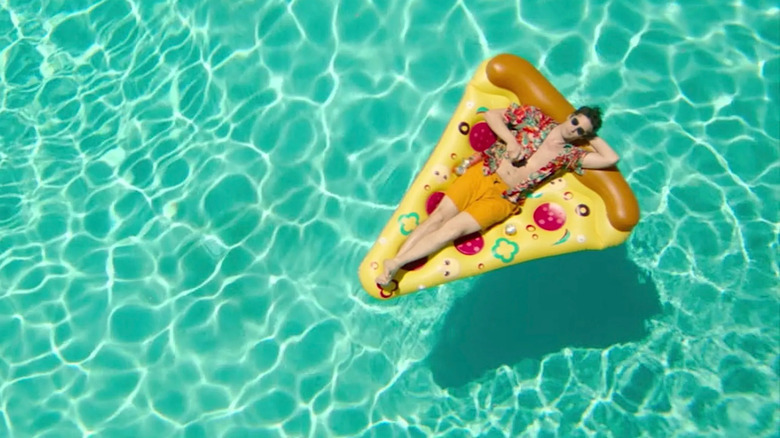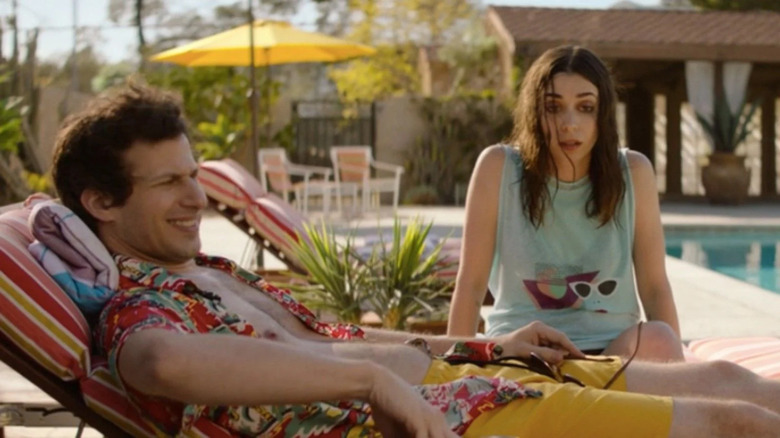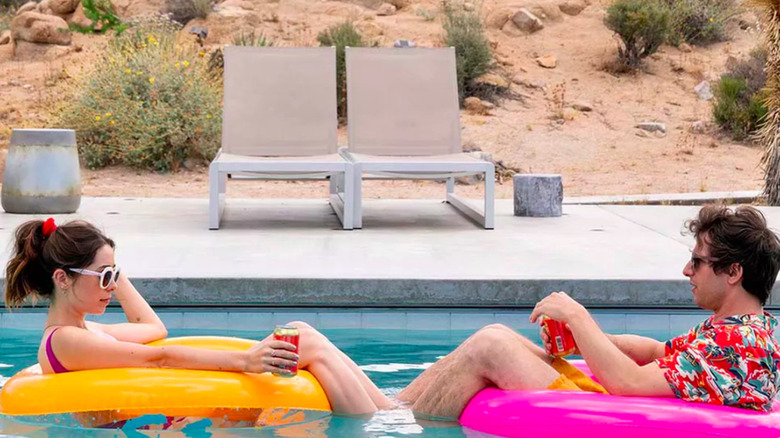Why Palm Springs Couldn't Actually Be Shot In Palm Springs
Independent filmmaking is a lot like running a household. You might have big ambitions for the month, but you are beholden to your monthly budget. Sometimes you're forced to scratch together macaroni and cheese with old noodles and some almost-expired cheese squares you find in the back of the fridge, and the kids will still love it. This was the case with the 2020 independent romantic comedy "Palm Springs."
The Andy Samberg vehicle debuted on Hulu in July 2020 after impressing at the Sundance Film Festival. The timing for the release of "Palm Springs" was perfect. The movie's narrative about two cynical millennials caught in an infinite time loop captured the mood of a country that was weary after Covid-19 shutdowns, and its debut came as theaters were shuttered due to the pandemic.
While the timing of the release might have been perfect, getting "Palm Springs" made was another story. The filmmaking duo Max Barbakow and Andy Siara faced an uphill battle to get the project going, including the inability to film in the city they named their movie after.
They were priced out of Palm Springs
Palm Springs, California, dubs itself as "Hollywood's backlot." Boasting picturesque scenery and classic architecture, the city is a postcard come to life and the perfect place to film a movie. It also made for the ideal location that Barbakow and Siara settled on for the wedding in "Palm Springs."
There was just one problem. According to The Hollywood Reporter, the budget was so thin, around $5 million, they couldn't afford to film in the city they named their film after. Producer Becky Sloviter said:
"I remember Andy [Samberg] and I squealing with delight and envisioning shooting the movie in Palm Springs over a couple of months. I had a budget and I had a script, and they were not matching up."
With Palm Springs too expensive, the production team settled on northeast Los Angeles County, with most of the production taking place in Santa Clarita and Palmdale. With the locations locked down, the filmmakers had to figure out how to make the most of a very limited budget.
They used toys for a storyboard
The production team certainly knew how to make the most of a limited budget, relying on an unconventional technique in the pre-planning process. Instead of professionally crafted storyboards, Barbakow and cinematographer Quyen Tran created them in Tran's living room using children's toys, such as Playmobil figures and whatnot. The exercise proved fruitful, providing an accurate template for a film whose budget demanded careful pre-planning. Tran said, "The shots on the [toy] sets exactly match what we ended up shooting."
Andy Samberg is a co-producer on the film and gave the indie just enough star power. While not a full-on leap into drama, "Palm Springs" offered Samberg a chance to show off a softer side. His character helps a trainwreck of a bridesmaid navigate the time loop while ultimately winning her heart. It's a nice leap for a comedian widely known for "SNL Digital Shorts" with The Lonely Island like "D**k in a Box" and silly comedies like "Hot Rod." While Samberg remains his same affable self in the film, there's a depth that been missing in his prior performances. Not a re-invention as much as an evolution for Samberg.
"Palm Springs" was a hit at the Sundance Film Festival, and the filmmakers saw an immediate return on their investment. The movie sold at the festival for $17.5 million, which set a record as the most expensive sale at Sundance by 69 cents. As Samberg's "Brooklyn Nine-Nine" character Jake Peralta might say, "Noice." That figure was later pushed to $22 million due to a bonus structure. The film also broke Hulu's opening weekend record. Pretty impressive for a film that couldn't even afford to shoot in the city for which it was named.


